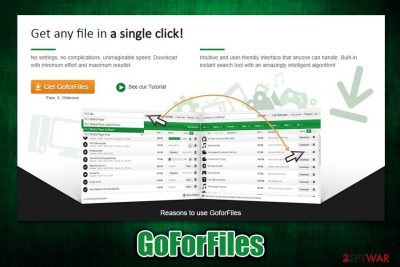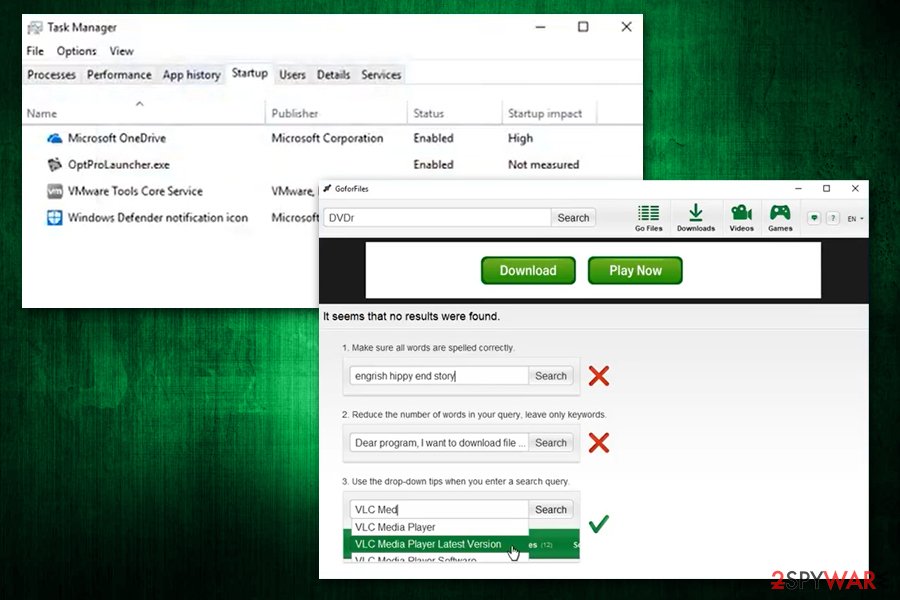GoForFiles (Removal Guide) - Dec 2019 update
GoForFiles Removal Guide
What is GoForFiles?
GoForFiles is a download manager you don't want on your computer

GoForFiles is a potentially unwanted program that leverages peer-to-peer[1] functionality in order to let users search for videos, movies, programs, and other items. Presented as a download manager for Windows devices, it may seem practical, as it supposedly allows users finding everything they need within a single search bar. However, GoForFiles is an app that you might regret installing almost immediately.
GoForFiles is often bundled with other malicious software and crapware,[2] so users might install it intentionally or as an optional component within a software bundle package. If not inspected thoughtfully, such installers often bring unwanted guests to the system. Upon successful entry, GoForFiles inserts startup items that allow it to launch with every system boot, display intrusive advertisements, and perform other unwanted activities. If you want to keep your system secure, you should start GoForFiles removal as soon as possible.
| Name | GoForFiles |
| Type | Potentially unwanted program, adware, malware |
| Functionality | Allegedly, this PUP allows users to download files by using an built-in search via the P2P network |
| Background process | OptProLauncher.exe |
| Infection means | The unwanted app can appear on users systems after downloading and installing freeware from third-party sites or after exposure to fake updates as well as online scams |
| Symptoms | Intrusive ads are shown within the program window, startup items created, a scheduled task created, a background process running |
| Danger level | Medium. Can result in the installation of other potentially unwanted programs or malware; |
| Termination | You can use our manual removal instructions below or delete the threat automatically with anti-malware software |
| Recovery | To ensure all registry entries related to the PUP are eliminated and no system crashes are present after termination, use FortectIntego |
GoForFiles application has been around for many years and was mostly distributed on third-party freeware websites. The official website has been shut down, so users can no longer download the program from there. Nevertheless, it does not mean that there are no working download links for it, or that software bundles do not carry the GoForFiles virus.
Upon infiltration, GoForFiles will most likely introduce other potentially unwanted programs along with it, for example, bloatware Optimizer Pro. While other adware apps focus on settings modification of Google Chrome, Mozilla Firefox, Internet Explorer, and other browsers, this app goes much further – it establishes its own registry keys, creates a scheduled task under the name GoForFilesUpdate (located in C:\Windows\System32\Tasks\ folder), and enables startup items that launch the program with every system boot.
While some users might download GoForFiles because of its functionality, it is worth to mention that some files that could be found via the service might be illegal to download (i.e., copyrighted content), as the app works based on P2P functionality. Another downfall is that downloaded files might also be malicious, and infect the computer with a worm, Trojan, backdoor,[3] ransomware, or other dangerous malware.

It is also known that GoForFiles ads may appear when browsing the internet, prompting users to visit affiliated websites. Unfortunately, pop-ups, flashing windows, in-text links, and other intrusive ads, may lead to sites that are not secure, or even show scam pages that ask users to download unwanted programs or even malware. Thus, if exposed to suspicious content, never download anything and leave the site immediately.
The correct action would be to remove GoForFiles adware. It can be done with the help of anti-malware, which recognizes PUPs or by following our step-by-step guide below. Besides, because the app might insert ads into web browsers, we recommend resetting all the installed browsers. After GoForFiles virus elimination, we also advise scanning the PC with FortectIntego to fix virus damage done.
You can avoid potentially unwanted programs by carefully checking the installation instructions of the app
Software bundling became a standard for the potentially unwanted program delivery over the years, as it is extremely efficient. Reason for that being users' carelessness and quite a bit of deception from third-party sites or freeware authors.
In most cases, the installer is injected with additional applications as an optional offer that users can decline during the installation process. However, users are deliberately misled into installing these optional components by implementing such tricks as pre-ticked boxes, misplaced buttons, misleading offers, fine print text, etc.
Considering most users simply click the “Next” button until the installation is complete, the installation of unwanted programs is conducted on a massive scale. Most of the freeware sites operate the pay-per-install scheme, which means that each of such installations provides monetary benefits for the interested parties.
Unfortunately, end-users are the ones that end up with scareware, bloatware, and even malware on their machines. Luckily, these practices are slowly changing, and users are becoming more aware of online dangers thanks to the media, which exposes the importance of online security to the masses. On the other hand, there will always be people who are not careful enough, so this business model will hardly ever die. To avoid PUPs, security experts[4] recommend the following:
- If possible, download apps from official sources only;
- Avoid torrent sites and P2P networks;
- Before installing the app, read up on it online;
- Employ reputable anti-malware that could stop unwanted programs before the entry;
- Always pick Advanced/Custom settings when prompted;
- Read the fine print;
- Remove the ticks from pre-ticked boxes;
- Read installation instructions carefully.

Get rid of GoForFiles to ensure computer safety
GoForFiles removal is required to ensure that no malicious files enter via the peer-to-peer network. Besides, the app will displays intrusive ads within the program as well as outside of it, so web browsing sessions might become a nightmare. If you want to search for particular applications or other media, there are plenty of legitimate sources for that; e.g., YouTube for video streaming, Spotify for music, Steam for gaming, etc.
To remove GoForFiles, you should access the Control Panel to reach the Programs & Features section, and uninstall the app from there. Keep in mind that the PUP runs background tasks, which might prevent its elimination. In such a case, we suggest you employ anti-malware software that can recognize the GoForFiles virus and delete all its components from the system. Additionally, you should also reset the installed browsers to ensure that no ads show up during web browsing.
You may remove virus damage with a help of FortectIntego. SpyHunter 5Combo Cleaner and Malwarebytes are recommended to detect potentially unwanted programs and viruses with all their files and registry entries that are related to them.
Getting rid of GoForFiles. Follow these steps
Uninstall from Windows
To remove GoForFiles from your Windows machine, perform the following actions:
Instructions for Windows 10/8 machines:
- Enter Control Panel into Windows search box and hit Enter or click on the search result.
- Under Programs, select Uninstall a program.

- From the list, find the entry of the suspicious program.
- Right-click on the application and select Uninstall.
- If User Account Control shows up, click Yes.
- Wait till uninstallation process is complete and click OK.

If you are Windows 7/XP user, proceed with the following instructions:
- Click on Windows Start > Control Panel located on the right pane (if you are Windows XP user, click on Add/Remove Programs).
- In Control Panel, select Programs > Uninstall a program.

- Pick the unwanted application by clicking on it once.
- At the top, click Uninstall/Change.
- In the confirmation prompt, pick Yes.
- Click OK once the removal process is finished.
Remove from Microsoft Edge
Delete unwanted extensions from MS Edge:
- Select Menu (three horizontal dots at the top-right of the browser window) and pick Extensions.
- From the list, pick the extension and click on the Gear icon.
- Click on Uninstall at the bottom.

Clear cookies and other browser data:
- Click on the Menu (three horizontal dots at the top-right of the browser window) and select Privacy & security.
- Under Clear browsing data, pick Choose what to clear.
- Select everything (apart from passwords, although you might want to include Media licenses as well, if applicable) and click on Clear.

Restore new tab and homepage settings:
- Click the menu icon and choose Settings.
- Then find On startup section.
- Click Disable if you found any suspicious domain.
Reset MS Edge if the above steps did not work:
- Press on Ctrl + Shift + Esc to open Task Manager.
- Click on More details arrow at the bottom of the window.
- Select Details tab.
- Now scroll down and locate every entry with Microsoft Edge name in it. Right-click on each of them and select End Task to stop MS Edge from running.

If this solution failed to help you, you need to use an advanced Edge reset method. Note that you need to backup your data before proceeding.
- Find the following folder on your computer: C:\\Users\\%username%\\AppData\\Local\\Packages\\Microsoft.MicrosoftEdge_8wekyb3d8bbwe.
- Press Ctrl + A on your keyboard to select all folders.
- Right-click on them and pick Delete

- Now right-click on the Start button and pick Windows PowerShell (Admin).
- When the new window opens, copy and paste the following command, and then press Enter:
Get-AppXPackage -AllUsers -Name Microsoft.MicrosoftEdge | Foreach {Add-AppxPackage -DisableDevelopmentMode -Register “$($_.InstallLocation)\\AppXManifest.xml” -Verbose

Instructions for Chromium-based Edge
Delete extensions from MS Edge (Chromium):
- Open Edge and click select Settings > Extensions.
- Delete unwanted extensions by clicking Remove.

Clear cache and site data:
- Click on Menu and go to Settings.
- Select Privacy, search and services.
- Under Clear browsing data, pick Choose what to clear.
- Under Time range, pick All time.
- Select Clear now.

Reset Chromium-based MS Edge:
- Click on Menu and select Settings.
- On the left side, pick Reset settings.
- Select Restore settings to their default values.
- Confirm with Reset.

Remove from Mozilla Firefox (FF)
Remove dangerous extensions:
- Open Mozilla Firefox browser and click on the Menu (three horizontal lines at the top-right of the window).
- Select Add-ons.
- In here, select unwanted plugin and click Remove.

Reset the homepage:
- Click three horizontal lines at the top right corner to open the menu.
- Choose Options.
- Under Home options, enter your preferred site that will open every time you newly open the Mozilla Firefox.
Clear cookies and site data:
- Click Menu and pick Settings.
- Go to Privacy & Security section.
- Scroll down to locate Cookies and Site Data.
- Click on Clear Data…
- Select Cookies and Site Data, as well as Cached Web Content and press Clear.

Reset Mozilla Firefox
If clearing the browser as explained above did not help, reset Mozilla Firefox:
- Open Mozilla Firefox browser and click the Menu.
- Go to Help and then choose Troubleshooting Information.

- Under Give Firefox a tune up section, click on Refresh Firefox…
- Once the pop-up shows up, confirm the action by pressing on Refresh Firefox.

Remove from Google Chrome
To ensure no ads come back, you should reset Google Chrome:
Delete malicious extensions from Google Chrome:
- Open Google Chrome, click on the Menu (three vertical dots at the top-right corner) and select More tools > Extensions.
- In the newly opened window, you will see all the installed extensions. Uninstall all the suspicious plugins that might be related to the unwanted program by clicking Remove.

Clear cache and web data from Chrome:
- Click on Menu and pick Settings.
- Under Privacy and security, select Clear browsing data.
- Select Browsing history, Cookies and other site data, as well as Cached images and files.
- Click Clear data.

Change your homepage:
- Click menu and choose Settings.
- Look for a suspicious site in the On startup section.
- Click on Open a specific or set of pages and click on three dots to find the Remove option.
Reset Google Chrome:
If the previous methods did not help you, reset Google Chrome to eliminate all the unwanted components:
- Click on Menu and select Settings.
- In the Settings, scroll down and click Advanced.
- Scroll down and locate Reset and clean up section.
- Now click Restore settings to their original defaults.
- Confirm with Reset settings.

Delete from Safari
Remove unwanted extensions from Safari:
- Click Safari > Preferences…
- In the new window, pick Extensions.
- Select the unwanted extension and select Uninstall.

Clear cookies and other website data from Safari:
- Click Safari > Clear History…
- From the drop-down menu under Clear, pick all history.
- Confirm with Clear History.

Reset Safari if the above-mentioned steps did not help you:
- Click Safari > Preferences…
- Go to Advanced tab.
- Tick the Show Develop menu in menu bar.
- From the menu bar, click Develop, and then select Empty Caches.

After uninstalling this potentially unwanted program (PUP) and fixing each of your web browsers, we recommend you to scan your PC system with a reputable anti-spyware. This will help you to get rid of GoForFiles registry traces and will also identify related parasites or possible malware infections on your computer. For that you can use our top-rated malware remover: FortectIntego, SpyHunter 5Combo Cleaner or Malwarebytes.
How to prevent from getting adware
Choose a proper web browser and improve your safety with a VPN tool
Online spying has got momentum in recent years and people are getting more and more interested in how to protect their privacy online. One of the basic means to add a layer of security – choose the most private and secure web browser. Although web browsers can't grant full privacy protection and security, some of them are much better at sandboxing, HTTPS upgrading, active content blocking, tracking blocking, phishing protection, and similar privacy-oriented features. However, if you want true anonymity, we suggest you employ a powerful Private Internet Access VPN – it can encrypt all the traffic that comes and goes out of your computer, preventing tracking completely.
Lost your files? Use data recovery software
While some files located on any computer are replaceable or useless, others can be extremely valuable. Family photos, work documents, school projects – these are types of files that we don't want to lose. Unfortunately, there are many ways how unexpected data loss can occur: power cuts, Blue Screen of Death errors, hardware failures, crypto-malware attack, or even accidental deletion.
To ensure that all the files remain intact, you should prepare regular data backups. You can choose cloud-based or physical copies you could restore from later in case of a disaster. If your backups were lost as well or you never bothered to prepare any, Data Recovery Pro can be your only hope to retrieve your invaluable files.
- ^ Peer-to-peer. Wikipedia. The free encyclopedia.
- ^ Adrian Kingsley-Hughes. Crapware: Why manufacturers install it, what you can do about it, and why it's not going to go away. ZDNet. Technology News, Analysis, Comments.
- ^ Kim Zetter. Hacker Lexicon: What Is a Backdoor?. Wired. Technology magazine.
- ^ Usunwirusa. Usunwirusa. Security advice from Poland.





















